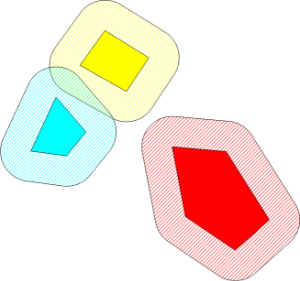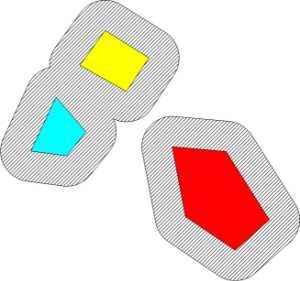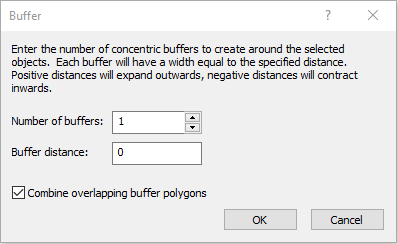Buffer
The Features | New Features | Buffer command creates a polygon around or within an object or group of objects at a specified distance. Any number or combination of points, polylines, spline polylines, polygons, rectangles, rounded rectangles, and ellipses can be selected before clicking the Buffer command. A polygon will be created around each selected object.
If Combine overlapping buffer polygons is checked in the Buffer dialog, the newly created buffer polygons are combined as with the Union Polygons command. For detailed explanation of the combination operation, see the Difference between Combine Islands/Lakes and Union Polygons section of the Union Polygons help page. The following images provide a visual example of the difference between using the Buffer command with and without the Combine overlapping buffer polygons option checked.
|
|
|
|
The Combine overlapping buffer polygons option was not checked in this example. Notice the overlapping region between the yellow and blue buffer polygons. Three new polygons were added to the plot window and Contents window. |
The Combine overlapping buffer polygons option was checked for this example. Notice the buffer polygons created from the yellow and blue polygons have been combined. Here the buffer polygons are a single complex object consisting of two sub-polygons. Only one polygon was added to the Contents window. |
Creating a buffer polygon
- Select the object around which to create a buffer polygon by clicking the object in the plot window or Contents window.
- Click the Features | New Features | Buffer command or the
 button.
button. - Specify the Number of buffers and Buffer distance and select whether to Combine overlapping buffer polygons in the Buffer dialog.
- Click OK, and the buffer polygon is created.
Buffer Dialog
The options for the Buffer command are located in the Buffer dialog. Open the Buffer dialog by selecting one or more objects and clicking the Features | New Features | Buffer command.
|
|
|
The number of buffers and buffer distance is specified in the Buffer dialog. |
Number of Buffers
Specify the number of buffers you wish to create around each object in the Number of buffers field. Type a number into the field or click the  buttons to change the value. The first buffer is created at the Buffer distance from the object, and subsequent buffer polygons are created at the Buffer distance from the previous buffer polygon.
buttons to change the value. The first buffer is created at the Buffer distance from the object, and subsequent buffer polygons are created at the Buffer distance from the previous buffer polygon.
Buffer Distance
Specify the distance to draw the buffer polygon from the selected object or group of objects in the Buffer distance field. Positive distances expand the buffer polygon. Negative distances contract the buffer polygon. A buffer polygon with a negative Buffer distance is not created for points or polylines.
The Buffer distance is specified in the source coordinate system distance units, e.g. degrees, feet, meters, or miles. For objects that are not part of a base layer, the Buffer distance is in page units (inches or centimeters).
Combining Buffer Polygons
Click the Combine overlapping buffer polygons check box to combine the buffer polygons after they are created. Overlapping buffer polygons will combine to form a single polygon. When the buffer polygons do not overlap, the buffer polygons are combined into a single complex polygon.
The buffer polygons are combined as with the Union Polygons command. For detailed explanation of the combination operation, see the Difference between Combine Islands/Lakes and Union Polygons section of the Union Polygons help page.


